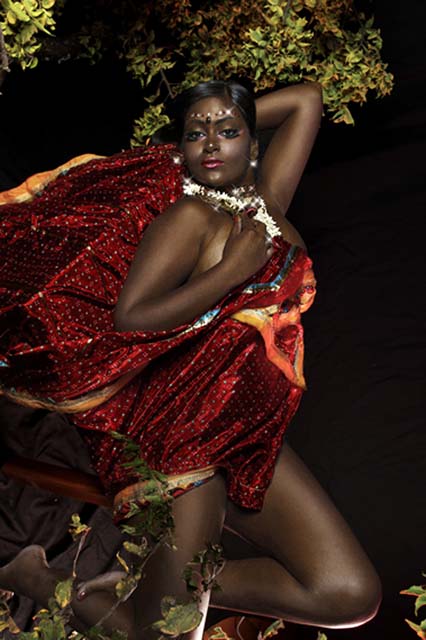
Unsuitable Girls: Telling Their Own Stories
South Asian women artists in New York find a space of their own & a freedom to be themselves, celebrating their view of the world…
If you happen to be from India, Pakistan or Bangladesh, a white china cup with steaming chai may conjure up thoughts of a tense evening with a prospective groom and his family. Tea is what is served by a single young woman, dressed in her demure best, being evaluated as a suitable bride.
Sa’dia Rehman, a young artist in New York, has taken this painful memory from the lives of mothers, sisters and friends, and turned tea-cups into powerful testimony: each white cup, embedded in the wall, has text which girls hear all too often in a patriarchal society: “After you settle down, your life will begin!” or even more often, “He’s an Engineer!”
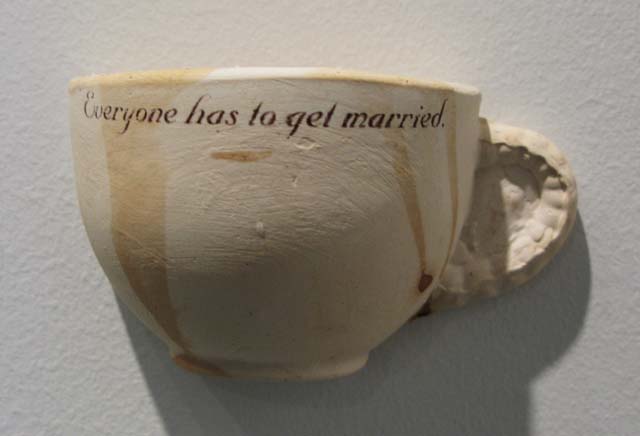
The Birth of SAWCC
That was then, 15 years ago, at an art exhibition in New York presented by a nascent organization called South Asian Women’s Collective (SAWCC). The exhibition was appropriately enough called (un)Suitable Girls – celebrating young women who wouldn’t have the arranged marriages and dowries like their mothers, the messy outspoken girls who might horrify prospective in-laws with their bitchiness and their wanton western ways. It’s about anger and angst, about questioning society’s iron-clad rules.
“The motif of suitability vs. unsuitability rings true for all South Asian women,” said artist-activist Jaishri Abichandani who founded the collective in 1997. ” We all know the societal terms of suitability: submissiveness, ‘fairness’, beauty, ‘good’ family, professional status, etc. (un)Suitable Girls is challenging the age-old notion that women are commodities to be bought, sold, advertised and owned.”
Fast forward fifteen years and I’m once again at an art exhibition, this time called ‘Her Stories’ commemorating a decade and a half of SAWCC and yes, Sa’dia’s teacups, provocative as ever, are on the wall, along with the work of other women artists from the Indian sub-continent. Her Stories presents the creative works of more than 100 diasporic South Asian women artists, filmmakers, musicians, dancers, and writers, with an installation of archival photographs, publications, and ephemera.
It’s hard to believe but this group of bold, feisty young artists is all-grown up now, and the art is still as in your face, just as ‘unsuitable’.
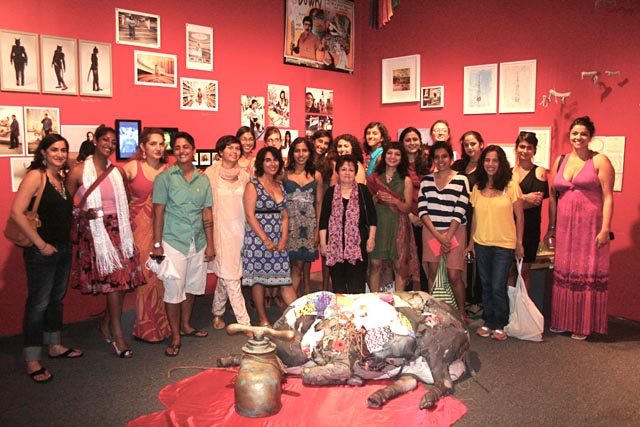
Abichandani founded SAWCC at a time when there were few resources for South Asian women artists, to nurture them and help them find their voice as brown women in a predominantly white world. Jaishri, who has a Master of Visual Arts Degree from Goldsmiths College, University of London, also helped to start a UK chapter of SAWCC.
In her essay for ‘Her Stories’, Abichandani points out that SAWCC has drawn inspiration from other activist groups such as the Black Arts Movement in the UK, as well as the progressive South Asian arts festival Desh Pardesh in Toronto. She emphasizes:”What has set SAWCC apart from our local peers was our pioneering commitment to making art, and to date we remain the only exclusively feminist space.”
Over the years SAWCC’s reach has extended to scores of artists, writers and performers, meeting informally in rented space in Manhattan. Social media has now extended its reach to many countries and the group has over 6000 members on Facebook.
“Before SAWCC, I didn’t have any South Asian friends at all. I didn’t know there were South Asian artists – I thought I was the only one,” recalled Safia Fatemi, a noted commercial artist, of those early days. “ The South Asians I met were engineers or going to medical school and every time I talked to them about art, they kind of looked at me as if I was strange. And then I came across this group and it completely changed my life.”
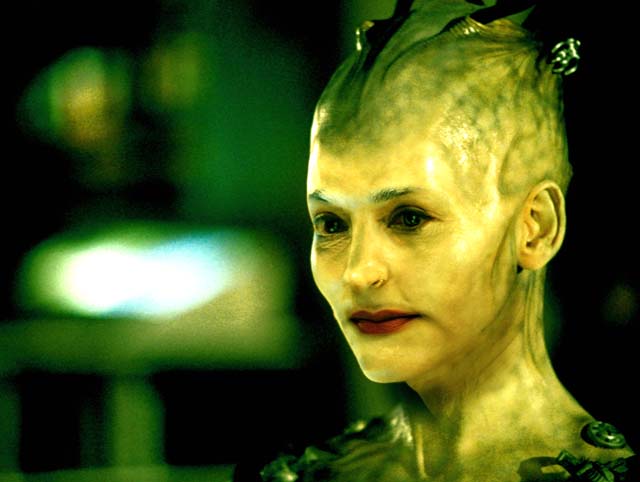
SAWCC: A Space of their Own
The Collective has helped provide visibility as well as connections for artists through its programming and dialogue with the larger art world. It’s all about sisterhood, a peculiarly South Asian brand of feminism and camaraderie. Many emerging artists have found a fertile nurturing ground and have gone on to be shown in galleries and get media attention. At the same time SAWCC finds support from noted artists like Shazia Sikander, writer Jhumpa Lahiri or film maker Mira Nair who donated an advance screening of ‘Monsoon Wedding’ to raise funds for SAWCC.
Prerna Reddy, a board member, is an arts administrator and a founder of Third Eye. She says, “Basically we feel South Asian women have not had a space in the mainstream art world and our aim is to develop artists work and give them a space for exhibition where curators can see it. We want to show there’s a high level of work and we always seek curators that are well-known.” In fact, one of the early shows was juried by Shamim Momin and Raina Lampkins-Fielder, both of the Whitney Museum of American Art.
In a world where the trend seems to be towards a one-size fit all global art, many ethnic voices tend to get marginalized. “ Often what happens is artists have to empty or remove a lot of the cultural sensibility to gain wider acceptance,” says Abichandani, “ and this evacuation of cultural identity from an international contemporary art context is why SAWCC becomes so necessary.”
Some of the artists nurtured by SAWCC have made it big in the global art world, others have found their place while still others are emerging artists. This 15th year retrospective received critical acclaim, including a glowing piece in The New York Times.
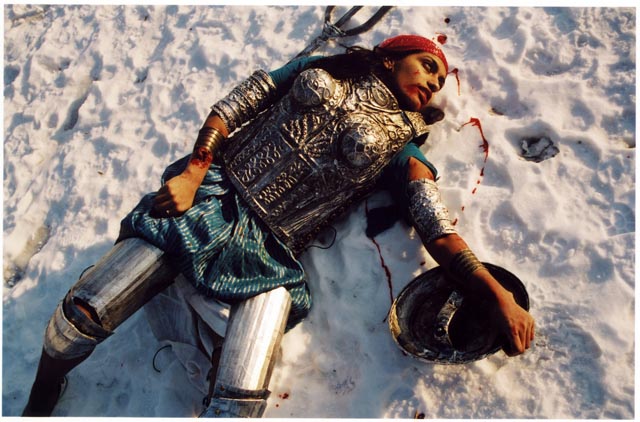
“This Small Power Generator”
Calling it “this small power generator of an anniversary survey” Holland Cotter wrote: “Ethnic stereotypes are deftly punctured in Jayna Mistry’s strenuously exotic fashion photos and in Meenakshi Thirukode’s film in progress of art world striving. Chitra Ganesh’s mesmerizing warrior-goddess self-portraits; Samira Abbassy’s dark-skinned fetish figures; and Ms. Abichandani’s photographic self-image as an extraterrestrial all give the concept of “undocumented alien” a new meaning.”
So what is so special about the work of these artists? It is honest and true, story-telling without inhibitions, using all media from painting to sculpture to video to installation, from performance to the written word, addressing everything from gender to politics to immigration, lost homelands and splintered identities.
“ I think that as culture gets dispersed, the information that gets disseminated doesn’t stay within categories,” says one of the early SAWCC women, Chitra Ganesh, who has become a rock star in the art world. “Oral histories, personal histories, sometimes stories – traumatic experiences they underwent in the family during events like the Partition, and sometimes its material from comic books – all these different forms come together to produce history.”
SAWCC Art Gallery
And that is what is so special about the work of these artists – their own take on history. It is honest and true, and told like it is, using myth, melodrama and magic to emphasize their point. There’s Ruby Chishti’s water buffalo with a gigantic tap for a head, lying in a pool of blood – drained dry by a world of greedy takers; Annu Palakunnathu Mathew uses digital technology to re-interpret Bollywood posters, turning these slick commercials on their head to challenge the crimes of Indian society; Swati Khurana embroiders beautiful dowry items with her two grandmothers for a groom-less wedding. As she says, “I explore immigrant issues and personal narratives with a focus on gender, popular culture and the seductive promises made by rituals.”
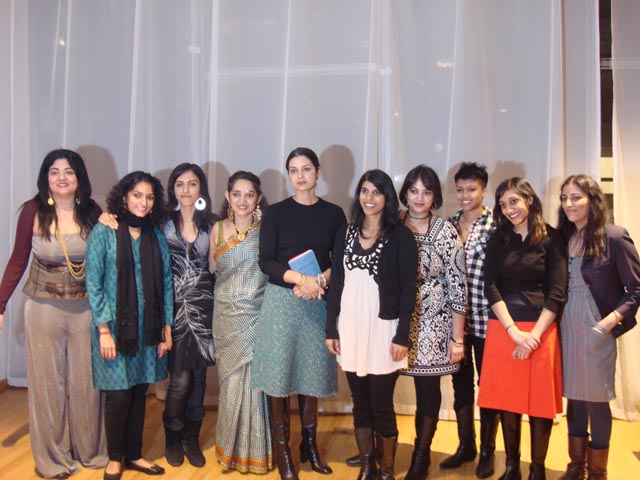
Art’s Women Warriors
What is amazing is that these women are all highly accomplished and successful in the world of arts. “I am truly humbled when I think of how so many of us have grown in the past 15 years, pursued advanced study for our creative and academic degrees, formed new organizations and creative companies,” says Swati Khurana. “We’ve written books, had solo exhibitions, made albums. It is no question to me, that for many of us, the support of a creative community and network, like SAWCC, enabled us to pursue our dreams.”
In spite of the changing times, many feel that SAWCC’s still got a big role to play. ” Many South Asian artists have gained a high level of success and visibility over the past 15 years, but there are still many challenges for women artists in the Diaspora,” says visual and media artist Shelly Bahl. “SAWCC is poised to meet these challenges and to maintain a strong community for emerging and established artists and art lovers.”
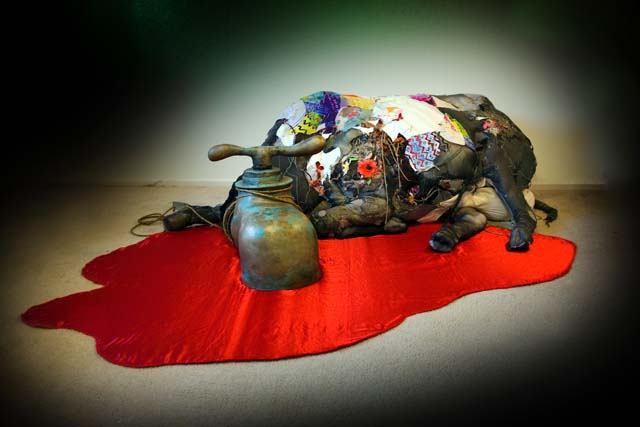
New Immigrants, New World
SAWCC has no membership dues and is totally volunteer-driven. It has monthly events presenting the work of South Asian women artists, a writing workshop called Brown Eyed Girls; Practice/Process/Portfolio, a studio circle for visual artists; a listserv for South Asian women; and annual exhibitions and festivals open to the public.
For new immigrants it is still a way to find one’s bearings in a new world. Josheen Oberoi, a specialist in South Asian art with the auction house Saffronart, recalls, ” When I first came to New York, it was such a comfort to find an intellectual space that allowed interaction with South Asian women who were practitioners of art, in one form or the other. I realized that SAWCC- pronounced saucy- was the perfectly appropriate pronunciation for this community of women where each meeting was an honest exchange of ideas, debates – absolute firecrackers of discussions and where each diverse voice was heard.”
(C) Lavina Melwani
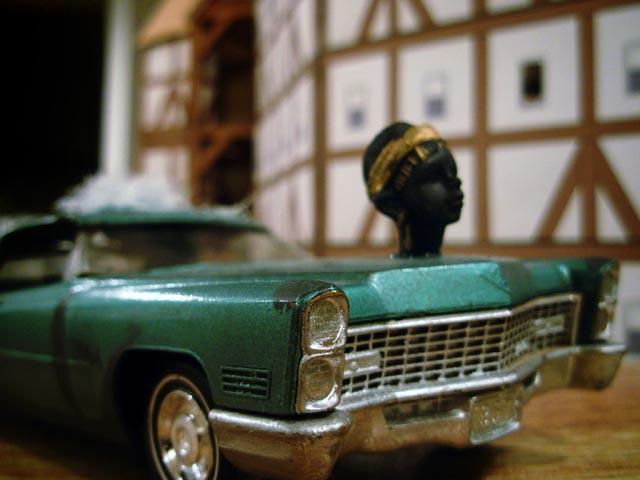
The Who’s Who of SAWCC at Her Stories, A 15 years Retrospective
Samira Abbassy, Jaishri Abichandani, Nida Abidi, Fariba Alam, Indrani Ashe, Shelly Bahl, Anjali Bhargava, Monica Jahan Bose, Marcy Chevali, Nandini Chirimar, Ruby Chishti, Poulomi Desai, Mariam Ghani, Roya Farassat, Chitra Ganesh, Hayat Gul, Aisha Abid Hussain, Vandana Jain, Mona Kamal, Jesal Kapadia, Asma Kazmi, Tara Kelton, Sarita Khurana, Swati Khurana, Pooneh Maghazehe, Annu Matthew, Samanta Batra Mehta, Jayna Mistry, Sabelo Narasimhan, Yamini Nayar, Bhanu Palam, Shruti Parekh, Amruta Patil, Kaveri Raina, Sa’dia Rehman, Tara Sabharwal, Sadia Salim, Negin Sharifzadeh (Moss), Pallavi Sharma, Meenakshi Thirukode, Anahita Vossoughi, Nazneen Ayyub Wood.
Her Stories, Your Stories…
Her Stories profiles established and emerging artists across the South Asian diaspora, including the US, South Africa, Canada, and the UK. The exhibition includes recurring themes such as self-portraiture, with women imagining themselves as goddesses, dead queens, cats, fathers, and cyborgs. Employing embroidery, digital manipulation, automated techniques, and other processes, artists Chitra Ganesh, Jaishri Abichandani, Nazneen Ayyub Wood, Aisha Abid Hussain, Jayna Mistry, Mona Kamal, and Swati Khurana present emotive images of varying historic registers. Annu Matthew, Anjali Bhargava, Sabelo Narasimhan, and Mariam Ghani offer photographs of bodies coded with racial signifiers.
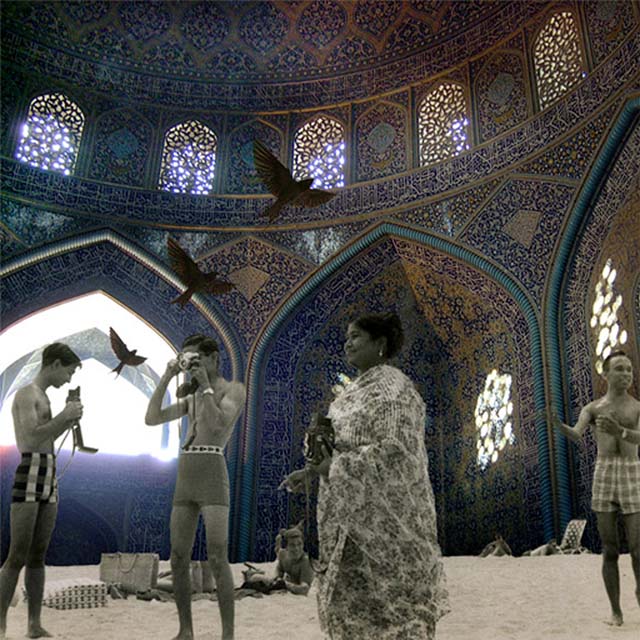
Also on display are Yamini Nayar’s photographs that incorporate miniature model sets photographed by large-scale cameras; her point of departure from personal signifiers to formal concerns is apparent in the selected work. The idea of the miniature is echoed throughout the exhibition via the small scale of most of the works on display; the installation is in direct reference to South Asian art historic traditions. The transformation of traditionally segregated female spaces into self-directed feminist ones is evidenced in the works of Roya Farassat, Samira Abbassy, Sa’dia Rehman, and Nida Abidi. Their work packs a bite that is softened by the meditative, gentler works of Nandini Chirimar, Samanta Batra Mehta, Tara Sabharwal, and Kaveri Raina.
Sculptures and installations by Vandana Jain, Indrani Ashe, Pooneh Maghazehe, Hayat Gul, Fariba Alam, Marcy Chevali, Monica Jahan Bose, and Pallavi Sharma occupy the walls, ceiling, and corners, while Ruby Chishti’s large sculpture of a cow with an oversized tap for a head envelops the floor, leaving each surface of the room adorned with artworks and a library installation of books by female South Asian authors. Our sister collective SAWCC London is represented by musician and SAWCC London co-founder Sonia Mehta, along with Poulomi Desai, Nazneen Ayyub Wood, and Aisha Abid Hussain.
(Source: Her Stories Fifteen Years of the South Asian Women’s Creative Collective)
(This article first appeared in Housecalls magazine)


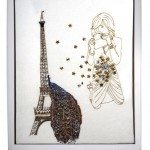

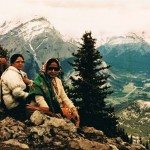
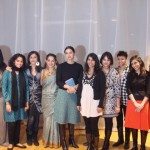
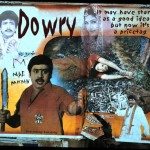
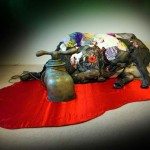
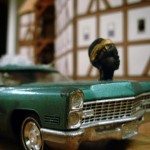
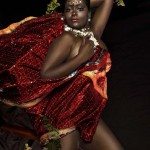
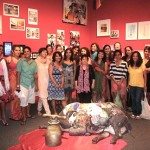

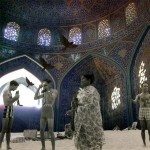
2 Comments
Thank you Indira Abichandani. I have been following SAWCC for over a decade and have written so many pieces about it for different magazines. Will be posting those here soon!
What a nice article. Lavina has done her research well and done full justice to the organization and the organizers. Very well written.